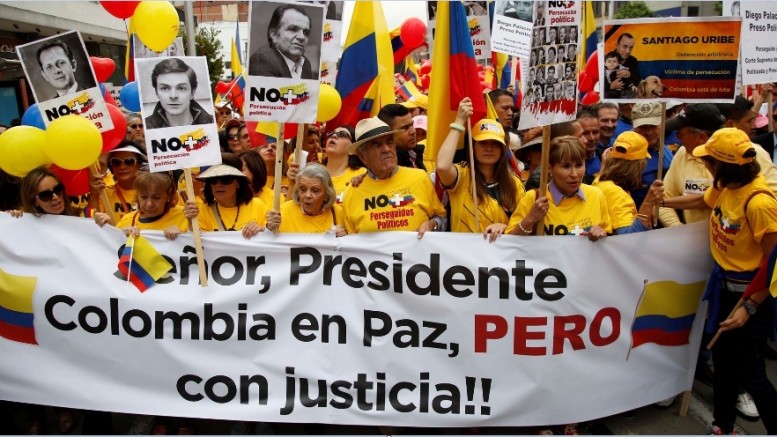On Oct. 2, Colombian voters in a national referendum narrowly defeated a peace agreement negotiated between the Colombian government and the Revolutionary Armed Forces of Colombia, or FARC, throwing the ongoing peace process into a fresh round of uncertainty.
The referendum question was: ¿Apoya el acuerdo final para terminación del conflicto y construcción de una paz estable y duradera? (Do you support the final agreement to end the conflict and build a stable and lasting peace?)
The “Si” vote in favour of the deal came in at 6.38 million (or 49.8% of valid votes), versus 6.43 million “No” votes (50.2%). The No side won by only 54,000 votes, and turnout was a mere 37%, with 13 million total votes from a potential field of 34.9 million eligible voters. Many blamed heavy rainfall in the country for the depressed turnout.
At 52 years and counting, Colombia’s civil war stands as Latin America’s longest-running hot conflict, with 220,000 dead, and millions injured and displaced. The countryside remains riddled with land mines.
The primary conflict between the national government’s armed forces and the Marxist FARC guerrillas is further complicated by the participation of the smaller National Liberation Army (ELN) left-wing guerrillas, so-called “right-wing death squads” and violent drug cartels, as well as the country’s falling, but still high, crime rate.
The U.S. government notably stepped up its military support of the Colombian government in 2000 with its US$9-billion Plan Colombia assistance package, even as Venezuela’s Hugo Chavez supported leftist guerrillas in Colombia as they crisscrossed between the two countries.
FARC’s active guerrilla membership numbers shrunk from 20,000 in 2002 to 7,000 currently, and its leadership took particularly hard hits in 2008, when senior leader Raúl Reyes was killed in a bombing raid and FARC founder Manuel Marulanda died of natural causes, and in 2011 when Alfonso Cano, who took over from Marulanda, was similarly killed in a bombing raid.
Colombian President Juan Manuel Santos’s government began talks towards a peace agreement with FARC negotiators in August 2012 in Havana, Cuba, and only concluded a final agreement in late August 2016.
The proposed agreement is said to have covered some of the most complex issues to have arisen in the conflict, including ceasefire schedules, rural reform, political participation and the problems with illicit drugs, as well as mechanisms to implement the agreement.
Even if they didn’t spend enough time securing actual votes, those promoting the Si side had the best stagecraft to accompany their campaign, culminating in a ceremony on Sept. 26, attended by UN Secretary General Ban Ki-moon, U.S. Secretary of State John Kerry and a dozen Latin American leaders, where Santos signed the agreement with FARC’s current leader Rodrigo Londoño Echeverri (aliases Timoleón Jiménez, or Timochenko) using a pen made out of bullet casings, and crowds waving Colombian flags with an extra white stripe added to symbolize peace.
The referendum result was a shock to many, as most Colombian and international media and left-leaning elites pitched the vote as a sure thing. President Santos, in power since 2010, staked all his political capital on the deal and ratcheted up the pressure for a Si vote by suggesting there was no “plan B” and that rejection of the deal meant a dissolution of the current ceasefire and a return to a shooting war.
On the other side of all this loomed influential former Colombian President and current Senator Álvaro Uribe — Santos’ predecessor and to the right of him on the political spectrum — who led the No side from his political base in Antioquia department. As president, Uribe leaned heavily on military victories over FARC and ELN forces, including retaking the Angostura gold deposit from guerrilla forces in open combat in the mountains south of Bucaramanga.
“No” voters wanted the FARC commanders sent to prison for their crimes, to be prohibited from entering the national Congress and to forfeit ill-gotten land and money — all items the “Yes” side considered worthwhile trade-offs for lasting peace.
A magnanimous Uribe said after the votes were tallied that all Colombians “want peace, no one wants violence,” while from Havana, Londoño called on the peace agreement to proceed and said it couldn’t be undone despite Sunday’s vote, and that “Peace with dignity arrived, and will remain.”
And so, for the mining community involved in Colombia, there are many reasons to believe it wasn’t peace that was rejected, it was this particular peace, and some new deal can be worked out between combatants in the years ahead.



Be the first to comment on "Editorial: Colombians reject peace deal, Uribe re-emerges as a force"